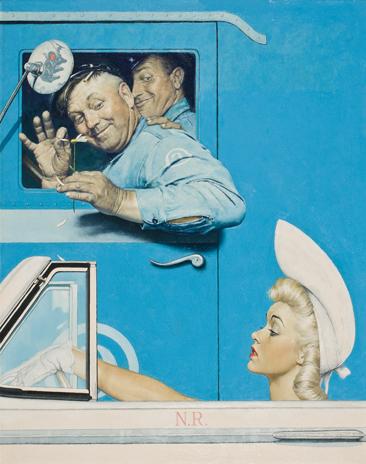Poor Norman Rockwell. The guy can’t get a break.
Every time there’s a big exhibition of his works — as there is now at the Smithsonian American Art Museum — you can bet your mortgage that someone, somewhere in the art world is going to scream bloody murder.
As in: he’s not a real artist, he’s kitschy, his paintings — most of them originally seen as magazine covers — are too corny, too rosy in their vision of America to be true.
You can debate all of these points to a fare-thee-well and inevitably, the debate starts to betray political views right alongside critical views.
Worst of all for his critics, perhaps, is that Rockwell, in his time, and right up to this moment, continues to remain popular.
Check it out: at almost any time during the week, the exhibition “Telling Stories: Norman Rockwell from the Collections of George Lucas and Steven Spielberg” is thick with people — young, old, parents and children, grandparents and grandchildren, older, for the most part, and white, for the most part. Tourists, for the most part.
There’s a thin line between populist and popular art, of course, and the geography of that line has so many footprints on it as to make it unidentifiable. Rockwell’s work is and always was squarely aimed at the great American working and middle class. It was meant to reflect an American landscape and people-scape that was easily recognizable.
What galls a lot of critics — even as far back as the 1920s — is that Rockwell’s work, excellent though it may be in brush strokes, draftsmanship and technique, straddles the thin line between illustration and art, per se. In the age of abstraction, Rockwell’s work sins again in that it doesn’t push forward, it cuts no edge, there’s nothing revolutionary in his work in terms of boundaries. And in the age of a rapidly changing America so diverse as to be almost unrecognizable, Rockwell’s people and imagery seem almost like a dream instead of having connection to reality.
And yet, here are the people in those rooms, trying to find themselves and a story. Rockwell lingers, like a hanger-on at a party for which he’s improperly dressed, just beyond the buzz, an elderly uncle with a bow tie.
To some critics, Rockwell’s work suggests an absence, a kind of intolerance that characterizes small towns steeped in sentiment, which, to critics of almost any kind of artistic work, is like garlic for a vampire. That kind of criticism, of course, is rife with intolerance itself.
“Norman Rockwell is an artist and a storyteller who captured universal truths about America that tell us a lot about who we are as a people,” said Elizabeth Broun, the Margaret and Terry Stent Director of the Smithsonian American Art Museum. That’s probably not entirely accurate — or, at least, it’s a little more complicated than that. Through his illustrations for Look Magazine, The Saturday Evening Post and, much later, his work that embraced the Civil Rights movement, Rockwell engages an ideal wish Americans have for themselves, the wish of the virtuous and bucolic nation where small things are big. Think for a moment about his great Thanksgiving painting — it’s almost THE holiday experience, which no doubt has inspired numerous movies about the holidays from hell as a counterweight. Yet it’s Rockwell’s painting we dream about if we dream.
This exhibition is about Rockwell’s story-telling gifts, and indeed, he had fantasized about wanting to become a director. His story-telling paintings are about what happened before and what happens after: here’s Gary Cooper being made up for a cowboy scene, here’s a sophisticated mom peering into a mirror, her daughter watching her; here’s truck drivers eyeing a blonde with manly admiration; here’s a bulky cop on a soda fountain with counter with a small boy; here’s a little girl on top of the stairs watching a Christmas party; here’s a woman being cajoled and yelled at by her fellow jury members; here’s a baseball rookie arriving at camp.
Here’s a boss, his red-haired secretary, a window-washer. At the exhibition, a mom explained the story to her daughter “He likes her, she likes him, she’s looking at him,” she said. “She’s not paying attention to her work. Maybe she’ll get fired. Maybe she’ll see the window washer outside. Maybe they’ll fall in love, go on a date. Maybe.”
This is what Rockwell does best: invite people into the stories in his paintings, backtrack, fast forward, wonder and speculate. It’s the stuff of the material that Lucas and Spielberg, both movie directors who themselves try not to visit too much the dark side where Darth Vader and post-modernism live.
His covers, illustrations, paintings and works of art may not be everybody’s cup of tea, and the America he portrayed may not include or be everybody’s America. It would indeed be a sad world if it were Rockwell’s world alone. But you can’t help but feel sometimes that we remember the works as real, even if they weren’t. If art is at least in part something that has the power to pull at you and not let go, then that’s art. It cuts through the edge where the heart and memory lies.










